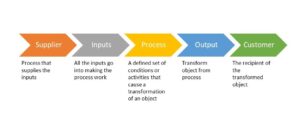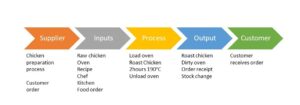What is a process from a manufacturer’s perspective?
A process is a set of steps and conditions that causes the transformation of a set of inputs into specified outputs. A simple example of a process is roasting a chicken, you have a set of conditions (time and temperature), an input (prepared raw chicken), and a specified output (a roasted chicken). In manufacturing you have a series of processes that takes a raw material and transforms it into a finished product.
A process is often only referred to as a ‘structured set of activities’, missing out the process conditions. I don’t think this is sufficient. If you take a mechanical activity like drilling a hole. The drilling a hole process is meaningless unless you define the type of drill bit, its approach in reference to the part, its rotation speed and approach velocity. However, this might say more about me as a chemist working in process manufacturing.
When you come to describe your processes, make sure you record all the important elements, and choose the right level of detail that is useful for your assessment.
Examples of processes
All businesses have processes. There are operational processes that create products and services, or administrative processes that help the business operate. Examples of manufacturing processes are, drilling, painting, drawing, cutting, grinding, cleaning, hair cutting etc. Examples of administrative processes are, roll call, marketing posts, sales calls, bank reconciliation, customer complaints, etc.
The common features of these processes are that they involve the transformation of an object (information, part, people), and they are often repeated. To help improve a business these processes should be standardised. For critical processes I would recommend spending the time to create SIPOC diagrams.
SIPOC diagram
The SIPOC diagram is a great process improvement tool used to define all the important elements of a process. You can use it at a very high level, to define a full production process, or at a very detailed level to look at a single activity. The tool splits a process into five parts: Supplier, Input, Process, Output and Customer. This is useful as it helps define the beginning and the end of a process, and how it links to others. It is very easy to lose important steps between processes through careless definitions. The SIPOC diagram is shown in figure 1.

Figure 1. SIPOC diagram showing the supplier, input, process, output and customer.
Let’s take a look at these five parts in more detail.
Supplier of a process
The suppliers are the source of any inputs. It could be an external supplier, for example a factory prepared chicken. Or it could be an internal supplier, for example you may have an internal process that prepares a chicken for roasting. The idea of internal suppliers is really important to process improvement. If you have an in-house process step that passes an object to your process, then they are your supplier, and you are their customer. A customer-supplier relationship should apply in your business as well as outside. As a customer to an internal process, you also do not want to receive out-of-spec material.
The supplier in the SIPOC diagram is not just the source of the raw material. There could be a supplier of the method, skills, equipment, or any of the resources that make up the process. For example, there may be a weighing step of the raw chicken that provides the cooking instructions for the roasting step.
Inputs of a process
The inputs are the key resources that are required for the process to work. These are the 4M and 1E; Manpower, Method, Machine, Material, and Environment. For our roast chicken example, this could be the cook, the recipe, the oven, the chicken, and the kitchen. When assessing a process, you often find an issue with the inputs, for example the cook might be busy elsewhere, or the oven is in disrepair and often provides the wrong temperature, or the kitchen is dirty and is a source of contamination of the roast chicken.
Process
This is the steps or conditions that are applied to the object to carry out the transformation. To clarify the object is the thing that is undergoing the transformation, it could be a material (like a chicken), a part (e.g., widget), a person (e.g., customer or patient), or even some information (e.g., a sales enquiry).
At this stage you should map out the detailed steps that make up the process, and/or define all the key conditions (e.g. time, temperature, pressure, speed, etc.). An example of a process map of the roast chicken is shown in figure 2.

Figure 2. Process map of Roast Chicken Process
Output
This includes all the outputs of the process. The focus is the specification of the transformed object, for example a roasted chicken, with brown crispy skin and with an internal temperature of at least 75°C. However, the outputs are not restricted to the product there may be other important outputs. There may be a change of status of any of the resource inputs. For example, the oven may be dirty and need cleaning before it can be used again. The location of the output may also be important. Is the role of the next process to collect the product? Does the roast chicken wait to be collected or is it moved to the next process? Another output that is easy to overlook is the process information. A lot of processes generate information, this may stay with the product as a batch document or be electronically transferred to a central database. Either way this process information is often important and needs to be logged as an output.
Customer
This could be an internal customer, i.e., the next process, or it could be an external customer, i.e., the consumer who is going to be eating the chicken. Understanding the customer is vital to a process, as it is them that defines the required output quality. If the customer is not happy then the process needs to be reviewed.
SIPOC diagram example
If we expand on the roast chicken example and say it is a shop that roasts chickens on order for external customers. We can create a SIPOC diagram for the chicken roasting process, this can be seen in figure 3.

Figure 3. SIPOC diagram of a chicken roasting process.
Now if the shop has an issue with a customer complaint, they can relate the complaint to the SIPOC and try and identify the cause of the issue. For example, an undercooked chicken could be related to problems with the recipe or the oven.
Summary
So, what is a process? From the SIPOC diagram’s point of view it is the supplier and all the inputs that are required for a transformation, the conditions, and steps to undergo the transformation of the object, the product of the transformation and the customer. Remember the object could be a material, information, or a person.
The benefit of the SIPOC diagram tool is that it forces you to map out all the key elements of the process, the result of the activity often uncovers obvious risks to the process’s success. It can also be referenced to support investigations into non-conformances or customer complaints.
If you are looking for help analysing your processes, then take a look at our process improvement page for more information, or for quicker results contact us for a chat.

